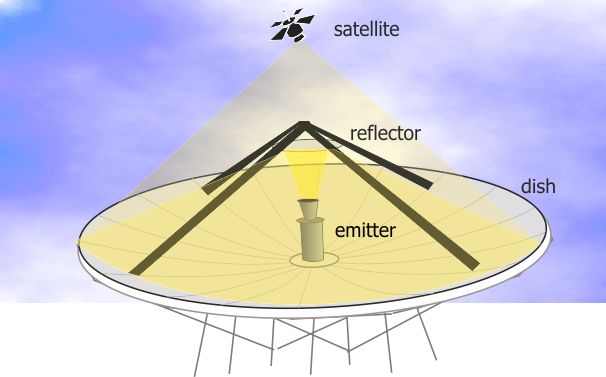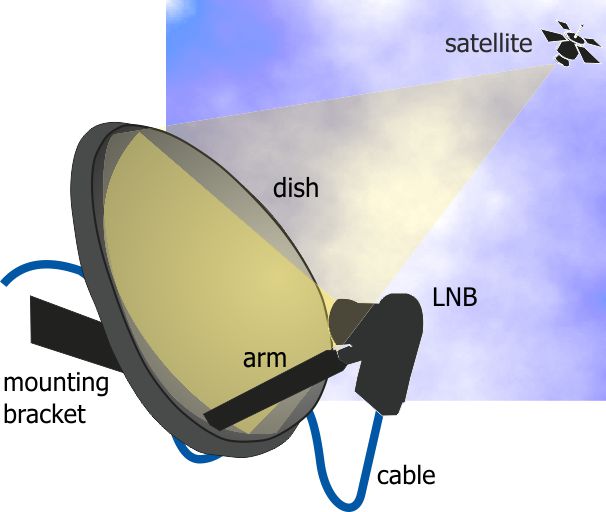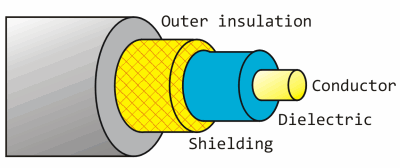Freesat reception - all about dishes
 Brian Butterworth published on UK Free TV
Brian Butterworth published on UK Free TV Satellite reception has both advantages and disadvantages compare with terrestrial (aerial) reception.
By using much higher frequencies (gigahertz, compared to terrestrial televisions megahertz) more transmission channels called transponders (the satellite equivalent of multiplexes) can be provided. For example, there are only six Freeview multiplexes, but Sky or Freesat users can access two hundred satellite transponders.
Aside from exceptional weather conditions (very heavy rain for example) digital satellite provides stable pictures and audio. Where Freeview transmitters are no more than 732 metres above sea level, the geostationary satellites used for television are 35,800,000 metres above the equator so reception is possible even where buildings, trees and hills make terrestrial reception impossible.

The downside of the transmitters being 22,300 miles up in the air is that the signals are very, very weak - so standard TV aerial is of little use. When the signals are sent to the satellites, huge dish transmitters are used to uplink the signal to the satellite. These are tens of metres from side to side, and feature an emitter that generates the signal, which is first bounced of a mirror (called a reflector) and then off the surface of the parabolic dish.

There are many satellites in the sky over the equator. Often these are in clusters over a particular position, for example there are four used for UK television are at 28.2 degrees east. There is another cluster over the 19.2 degrees east positions that are used for German television.
To receive these very weak signals from the satellite, it is necessary to use a dish for reception too. By using a reflective dish, this concentrates the signals onto a small device called a LNB. This is held in front of the dish by a metal arm.

The size of dish for reception is typically much smaller; often 60cm to 100cm in diameter, but the exact size depends upon the transmitting satellite transponder. To keep the transmission power levels down to levels that can be powered by the satellite's solar panels, each beam is focused on a particular area of the Earth's surface. If you are trying to receive the signal at the centre of this zone, a small dish is required. At the outer edges, you may need a 5 metre dish. Maps of these zones are provided by the satellite companies, and are called satellite footprints.
When the dish is installed it must be aligned carefully as the signal is very weak. The installer needs to know the inclination and the azimuth from the ground location to the satellite. If you install yourself you will find that there are markings on the dish that are used to point the dish in the correct position. It is important that the view of the satellite will not be blocked, so must take into account leaves growing on trees and potential building works.
For many people the LNB will have a single cable connected to it, however if you have Sky+ or a multi-room installation the LNB package will actually contain four receivers a quad-LNB. Unlike terrestrial television where you can split the aerial cable to feed more than one Freeview box or television set, with satelite reception you cannot. So, a Sky+ box with two receivers (so you can watch one thing and record another) has two cables connecting the box to the dish.
The cable that connects the dish to the receiver must be satellite grade cable. Whilst this looks superficially like the cable used to connect and aerial to a television, a higher grade cable is required for satellite reception.
Here is an image of a co-axial cable. This sort of cable is used to connect any type of receiving aerial to the reception equipment.

RG6, PF100 and PH100 are all types of coax cable that are suitable for the very weak signals that are received by a satellite dish. (The power is the same as you would receive from a one-bar electric heater on the moon).
The conductor in the centre passes the signals received from the dish to the set-top box. This is made from steel in RG6 cable, and from copper in the RF100 and PH100 types. This makes RG6 less suitable in the UK where rain can damage the cable.
The shielding is responsible for keeping unwanted external interference from damaging the signal. In the cheaper cable this will be a foil wrap, in better specified cables this is a braid (or mesh) of copper wires. The sheild in the RF100 covers 58% of the cable.
The non-conducting layer between the shield and the conductor is called the dielectric. This can be either a solid (RG6), foam (RF100) or air-spaced (PH100) dielectric. This makes the cables progressively more flexible (ie bendy without damage).
1:34 PM
Will an existing zone 2 dish receive Freesat+ and HD channels or do I need to upgrade to a new dish?
| link to this comment |
1:12 PM
Hi my name is Mickey,and from Serbia,Belgrade
so my question is,how to get freeview UK channels,BBC1,2,3 and ITV 1,2,3 4 and the rest of the freeview,I have got the SKY BOX, bought in UK,so how big dish do I need,and which satelite frekvency is for the southerneast europe???
Regards!!
| link to this comment |
Mickey: See "Where can I receive it" on the All about Freesat | ukfree.tv - independent free digital TV advice page please.
| link to this comment |
9:54 AM
Why is it that I have a freesat box fitted to an existing satellite dish originally picked up all channels, now wen American channels come on the tv turns black and will only show these channels wen the breaks come on ie friends simpsons wife swap it really don't make any sense. is there anything I can do as this is turning our Tele watching into a complete drag lol.
| link to this comment |
1:05 PM
Reading
daniel: I suspect your Freesat box is connected to your TV via HDMI? Most likely those channels are signalling the 'copy protected' flag. This causes the box to turn off digital outputs if the device it's connected to isn't considered trusted, using the HDCP protection.
TVs marked 'HD Ready' are supposed to do HDCP correctly, but there's a chance that there's a problem with it, or that the box only does HDCP handshaking when the channel is sending the 'copy protected' flag, and the TV isn't expecting it at this point. You could try unplugging the HDMI lead from the TV and plugging it back in. If you're using a computer monitor, it's possible that the monitor doesn't do HDCP at all.
| link to this comment |
Mike's: mapM's Freeview map terrainM's terrain plot wavesM's frequency data M's Freeview Detailed Coverage
3:12 PM
Hi there is it ok to paint my sky dish with
rust proof paint or will it effect the
signal.Thank you.
Elinor.
| link to this comment |
11:13 AM
Hi
I have a Panasonic TV with integrated Freesat via a Dish. I have signed up for Sky and wonder what the installation criteria is, for example do I need a further Dish or can I run both Freesat and Sky from my existing Freesat Dish.
ANY drawbacks or things I should be aware off when setting of down this route.
MANY thanks, PHIL
| link to this comment |
1:36 PM
Our TV is based in SWFrance with HD french and at present anologue UK TV all via satilite dishs.Is it possible to use Humax HD digibox reciever here with Freesat compatibility thereby being able to recieve most UK programes?Your advice please as I'm planning on obtaining a digibox for UK HD reception.
| link to this comment |